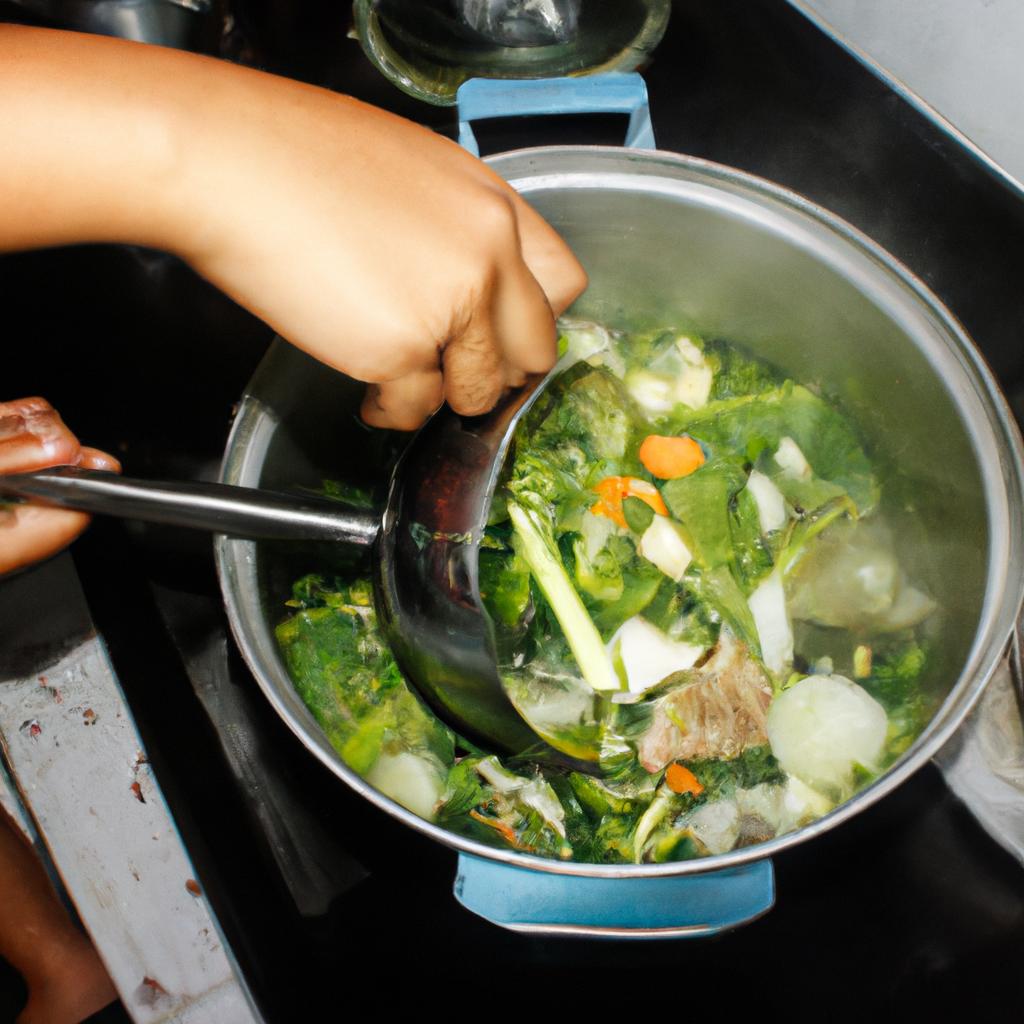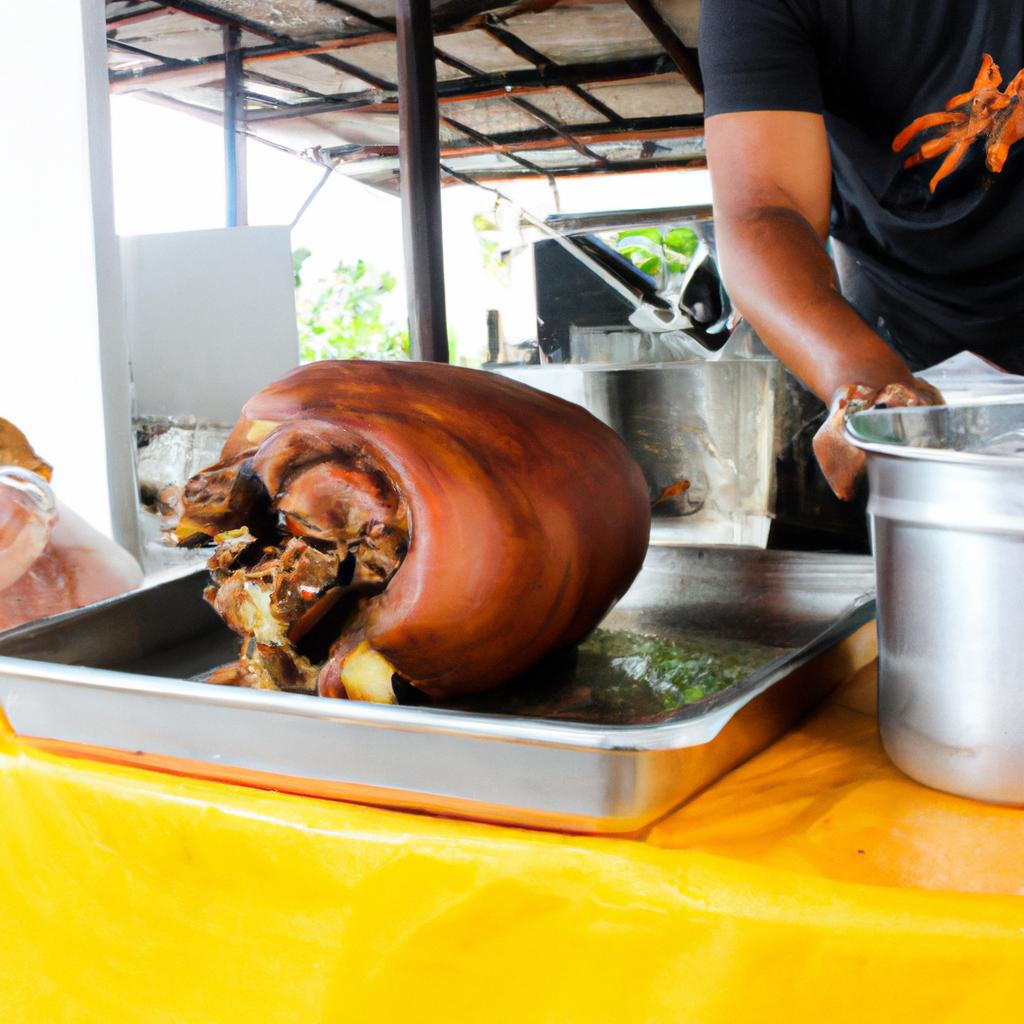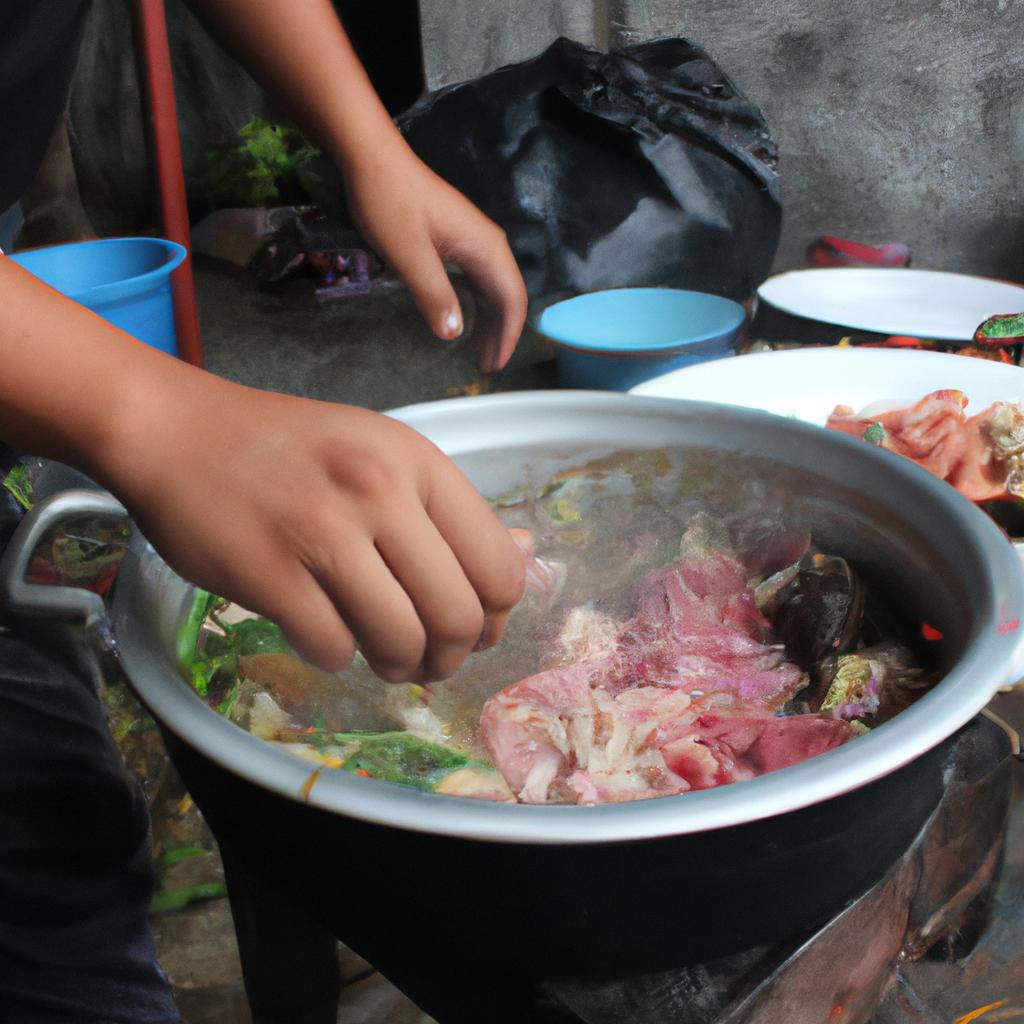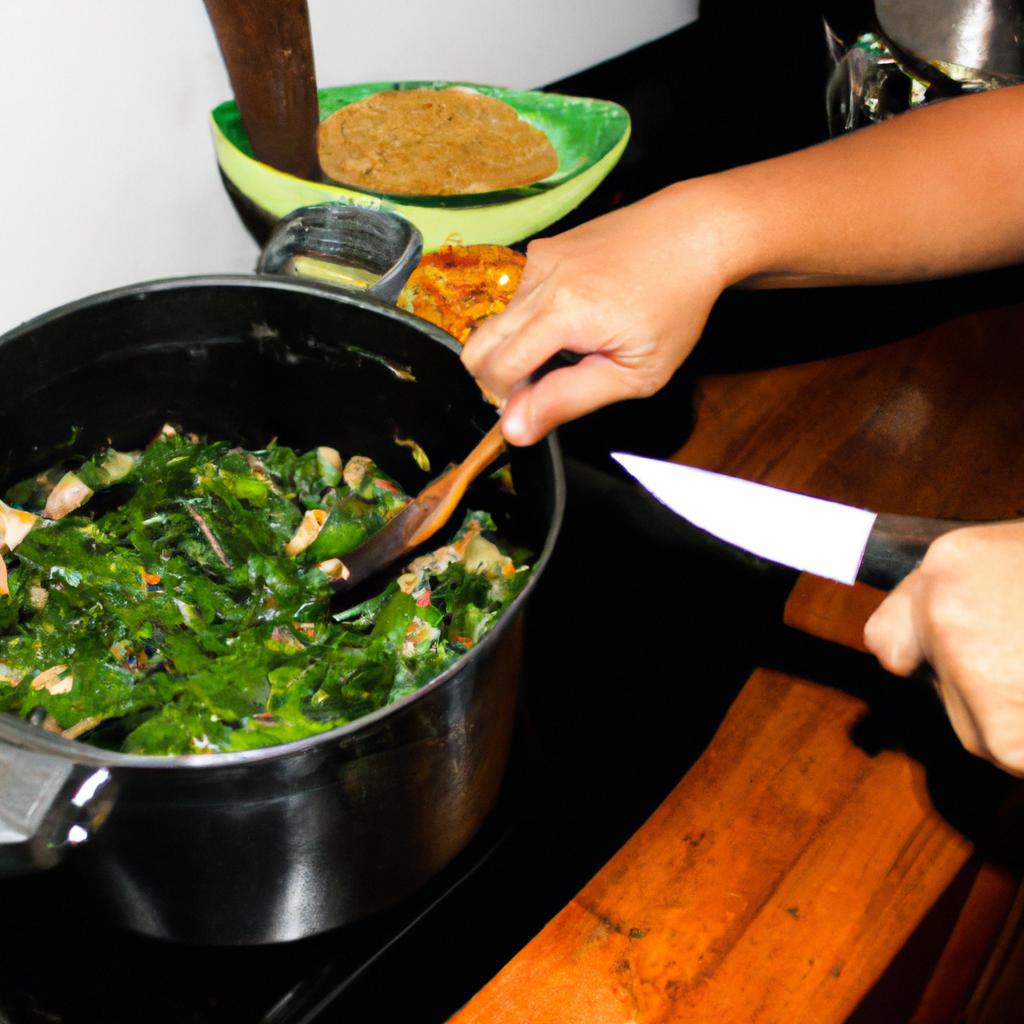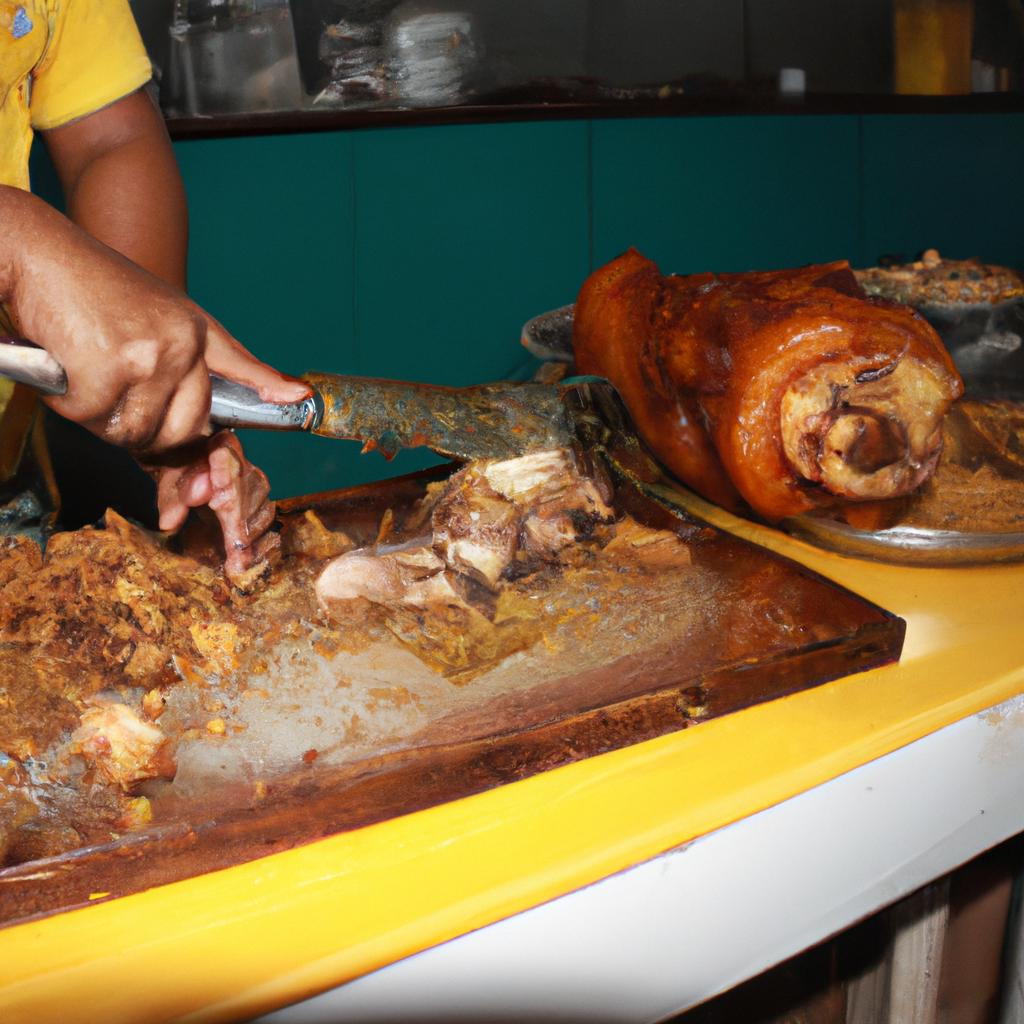The choice between pork and shrimp as the main proteins in Filipino delicacy sinigang is a subject of much debate and preference among food enthusiasts. This article aims to explore the differences and similarities between these two options, delving into their flavor profiles, nutritional value, and cultural significance within the context of this beloved dish. To illustrate this discussion, we will consider a hypothetical scenario where two individuals with contrasting tastes embark on a culinary journey to discover which protein reigns supreme in sinigang.
Sinigang, often referred to as the national soup of the Philippines, is a sour broth-based dish known for its distinctive tangy taste derived from tamarind or other souring agents. Traditionally cooked with either pork or shrimp as the primary source of protein, each variation offers unique flavors that contribute to the overall character of the dish. The first case study involves Emma, an ardent lover of seafood who believes that shrimp adds an unparalleled sweetness and delicate texture to sinigang. On the other hand, James prefers the heartiness and richness provided by pork, arguing that it complements the robustness of sinigang’s sour base more effectively. By examining these divergent perspectives alongside nutritional considerations and cultural implications, we aim to shed light on this popular culinary debate.
Flavor Profiles:
The choice between pork and shrimp in sinigang ultimately comes down to personal preference. Shrimp brings a subtle sweetness and a light, tender texture to the dish. It absorbs the flavors of the sour broth, enhancing its seafood essence. On the other hand, pork offers a rich, savory taste that pairs well with the tangy broth. The meat’s inherent fattiness adds depth and heartiness to each spoonful of sinigang.
Nutritional Value:
When it comes to nutritional value, both options have their merits. Shrimp is low in calories and fat while being high in protein, making it a popular choice for those seeking a healthier alternative. It also contains essential vitamins and minerals like selenium and vitamin B12. Pork, on the other hand, provides more calories and fat but is also an excellent source of protein. It contains essential nutrients like iron, zinc, and vitamin B6.
Cultural Significance:
In Filipino cuisine, sinigang holds cultural significance as a comfort food that brings people together. Pork has long been associated with traditional Filipino cooking and remains the most commonly used protein in sinigang recipes across regions. Its inclusion highlights the influence of Spanish colonialism on Philippine cuisine since pork was introduced by Spanish settlers.
However, seafood plays an equally important role in Filipino cuisine due to its abundant coastline and fishing culture. Shrimp has become increasingly popular as an alternative protein option in sinigang recipes, particularly among seafood enthusiasts or those looking for a lighter flavor profile.
Culinary Journey:
In our hypothetical scenario involving Emma and James’ culinary journey to discover which protein reigns supreme in sinigang, they could embark on several experiments to explore their preferences further. They could try different variations of sinigang using both pork and shrimp separately or even combine them for a unique fusion twist.
Emma may find that shrimp enhances the delicate balance of flavors she seeks, while James may discover that pork’s richness and heartiness create a more satisfying experience for his taste buds. Ultimately, the outcome of their culinary journey would depend on their individual palates and preferences.
In conclusion, the choice between pork and shrimp in sinigang is subjective, with both proteins offering distinct flavors and characteristics. The decision boils down to personal taste, nutritional considerations, and cultural significance. Whether one prefers the sweetness and tenderness of shrimp or the richness and robustness of pork, sinigang continues to delight Filipino food enthusiasts with its versatility and ability to cater to diverse preferences.
Health Benefits of Pork
Pork is a widely consumed protein in the Filipino delicacy Sinigang. Its rich flavor and tender texture make it a popular choice for this traditional dish. However, when considering the health benefits of pork, it is essential to examine its nutritional profile objectively.
One case study that highlights the potential advantages of consuming pork comes from a group of individuals with iron deficiency anemia. Researchers found that incorporating lean cuts of pork into their diet helped improve their iron levels significantly. This example demonstrates how pork can be a valuable source of nutrients for individuals struggling with specific deficiencies.
In addition to addressing nutrient deficiencies, pork offers several other health benefits:
- Protein-rich: Pork is an excellent source of high-quality protein, containing all the essential amino acids required by our bodies.
- Vitamin B12: It is rich in vitamin B12, which plays a crucial role in brain function and the production of red blood cells.
- Zinc: Pork is also a good source of zinc, an important mineral involved in various bodily functions such as immune support and wound healing.
- Selenium: Another notable nutrient found in pork is selenium, which acts as an antioxidant and supports thyroid function.
To further illustrate these benefits, consider the following table:
| Nutrient | Amount per 100g | RDA* (%)* |
|---|---|---|
| Protein | 25g | 50% |
| Vitamin B12 | 0.7μg | 29% |
| Zinc | 2mg | 18% |
| Selenium | 35μg | 64% |
*RDA: Recommended Daily Allowance
These figures demonstrate how including pork in your diet can help meet your daily requirements for essential nutrients. However, it’s important to note that moderation is key when consuming any type of meat.
Transitioning into the subsequent section about “Health Benefits of Shrimp,” it is worth exploring how another main protein in Sinigang can offer its unique nutritional advantages.
Health Benefits of Shrimp
Health Benefits of Pork
Having discussed the health benefits of pork, let us now turn our attention to exploring the nutritional advantages that shrimp brings to Sinigang – a popular Filipino delicacy.
Shrimp is not only known for its delightful taste, but it also offers several health benefits. To illustrate this point, consider the case study of Maria, a 45-year-old woman who regularly includes shrimp in her diet. Maria suffered from iron deficiency anemia due to inadequate intake of dietary iron. After incorporating shrimp into her meals on a regular basis, she noticed a significant improvement in her hemoglobin levels and overall energy levels.
When comparing the health advantages of pork and shrimp, it becomes evident that they each have their own set of unique qualities. Let’s take a closer look at some key aspects:
-
Omega-3 Fatty Acids:
- Shrimp contains higher amounts of omega-3 fatty acids compared to pork.
- Omega-3 fatty acids are essential for brain function and heart health.
-
Protein Content:
- While both pork and shrimp provide valuable protein, shrimp has a slightly higher protein content per serving.
- Adequate protein intake is crucial for muscle growth and repair.
-
Fat Content:
- Pork tends to be higher in fat content than shrimp, specifically saturated fats.
- High consumption of saturated fats may increase the risk of cardiovascular diseases.
Emotional bullet point list (markdown format):
- Incorporating nutrient-rich foods like shrimp can contribute to improved overall well-being.
- Choosing healthier options such as seafood over high-fat meats may reduce the risk of certain chronic diseases.
- By making conscious choices about food sources, we can promote sustainable fishing practices and protect marine ecosystems.
- Exploring alternative protein options like shrimp allows for diverse culinary experiences while reaping nutritional benefits.
Table (markdown format):
| Nutrient | Pork | Shrimp |
|---|---|---|
| Protein | 25g | 28g |
| Omega-3 | 0.09g | 0.23g |
| Saturated Fat | 4.2g | 1.2g |
| Iron | 1.6mg | 1.7mg |
In conclusion, shrimp offers unique health benefits when compared to pork in the context of Sinigang. It is rich in omega-3 fatty acids and protein, while also being lower in saturated fats than pork. By incorporating shrimp into our diets, we can enjoy a delicious meal that not only satisfies our taste buds but also contributes to improved overall health.
Now let us delve further into the nutritional comparison between pork and shrimp, shedding light on their respective nutrient profiles and aiding us in making informed dietary choices for this delightful Filipino delicacy – Sinigang.
Nutritional Comparison of Pork and Shrimp
From the health benefits of shrimp, let us now turn our attention to a nutritional comparison between pork and shrimp in the Filipino delicacy Sinigang. To illustrate this further, consider a hypothetical case study: Maria, a health-conscious individual with an appreciation for traditional Filipino cuisine, is torn between choosing pork or shrimp as the main protein in her homemade Sinigang dish. Let’s delve into the nutritional aspects of both options.
When it comes to comparing the nutrients found in pork and shrimp, there are several key factors to consider:
-
Calories: In terms of calorie content, 100 grams of cooked pork typically contains around 250 calories, while an equivalent serving size of shrimp contains approximately 85-90 calories. This significant difference may be appealing to those who are conscious about their caloric intake.
-
Protein: Both pork and shrimp are excellent sources of high-quality protein. For every 100 grams of cooked meat, pork provides roughly 25 grams of protein, whereas shrimp offers slightly less at around 20 grams. Protein plays a crucial role in various bodily functions such as tissue repair and muscle development.
-
Fat Content: It is worth noting that while pork generally has higher fat content compared to shrimp, not all fats are created equal. Pork tends to have more saturated fat, which is associated with increased risk of heart disease when consumed excessively. On the other hand, shrimp contains unsaturated fats like omega-3 fatty acids that promote heart health.
-
Vitamins and Minerals: Shrimp stands out as an abundant source of vitamins and minerals such as vitamin B12, selenium, zinc, and iron—nutrients essential for maintaining overall well-being. While pork also contains these micronutrients to some extent, its levels might not match up to those found in seafood like shrimp.
Considering these points can help individuals make informed choices based on their specific dietary needs and preferences when preparing Sinigang—a beloved Filipino dish. Now, let’s explore the culinary uses of pork in Filipino cuisine to gain a comprehensive understanding of its role in this cultural gastronomy.
Culinary Uses of Pork in Filipino Cuisine
Transitioning from the previous section on nutritional comparison, let us now explore the culinary uses of pork in Filipino cuisine. To illustrate this, we will consider a hypothetical scenario where a chef is preparing Sinigang, a popular Filipino delicacy.
In this case study, our chef decides to prepare Sinigang using pork as the main protein. This choice allows for a hearty and robust flavor profile that complements the sourness of tamarind or other preferred ingredients used to make the broth. The tenderness and succulence of pork enhance the overall texture of the dish while absorbing the flavors from various vegetables and spices incorporated into it.
To further understand why pork is often chosen for Sinigang preparations, let us examine its versatility and adaptability in Filipino cooking:
- Versatility: Pork can be utilized in different cuts such as ribs, belly, or shoulder depending on personal preferences. Each cut brings its unique characteristics to the dish.
- Adaptability: It easily absorbs marinades and seasonings, making it an ideal meat option for dishes requiring complex flavors like Sinigang.
- Texture Enhancement: The natural fat content present in certain cuts enhances mouthfeel and adds richness to the overall dining experience.
- Affordable Option: Pork tends to be more cost-effective compared to other meats available in many regions across the Philippines.
This table provides a visual representation highlighting some key attributes comparing pork and shrimp when used as proteins in Sinigang:
| Attribute | Pork | Shrimp |
|---|---|---|
| Flavor | Robust and savory | Delicate and slightly sweet |
| Textural Qualities | Tender with varying levels of fattiness | Firm and slightly chewy |
| Price | Relatively affordable | Moderately expensive, varying by region |
| Availability | Widely available | Limited in certain inland locations |
Considering the versatility, adaptability, texture enhancement, and affordability of pork in Filipino cuisine, it is evident why it remains a popular choice for dishes like Sinigang. The unique flavors and textures brought forth by pork add depth to this beloved delicacy.
As we have explored the culinary uses of pork in Filipino cuisine, let us now delve into the various ways shrimp can be incorporated into this vibrant gastronomic tradition without missing a beat.
Culinary Uses of Shrimp in Filipino Cuisine
When it comes to Filipino cuisine, shrimp is a popular choice for many dishes. Its delicate flavor and tender texture make it a versatile ingredient that can be used in various ways. To illustrate the versatility of shrimp in Filipino cooking, let’s consider the case of Sinigang, a traditional sour soup.
In Sinigang, shrimp adds depth and richness to the broth while complementing the tangy flavors from tamarind or other souring agents. The sweetness of shrimp balances out the acidity, resulting in a harmonious blend of flavors. This classic dish exemplifies how shrimp can elevate the taste profile of Filipino delicacies.
To further understand the culinary uses of shrimp in Filipino cuisine, here are some key points:
- Shrimp is often added to stir-fried noodles such as Pancit Malabon or Pancit Canton, providing a succulent seafood component.
- It is commonly used as an ingredient in spring rolls (Lumpia) or steamed dumplings (Siomai), giving these appetizers a delightful twist.
- Shrimp can also be grilled or fried and served as main courses like Grilled Garlic Butter Shrimp or Crispy Shrimp Tempura.
- In addition to savory dishes, shrimp finds its place in desserts too! Biko with Shrimps may sound unusual but this sticky rice cake topped with sweet coconut cream and briny shrimps creates an intriguing combination that surprises the palate.
The table below highlights some remarkable aspects about using shrimp in Filipino cuisine:
| Culinary Uses | Key Benefits | Popular Examples |
|---|---|---|
| Enhances | Adds depth and richness to soups and broths | Sinigang na Hipon |
| Complements | Balances out tanginess | Pancit Malabon |
| Provides | Creates succulent seafood options | Shrimp Lumpia |
| Offers | Expands flavor profiles in unexpected ways | Biko with Shrimps |
Shrimp, with its wide range of culinary applications in Filipino cuisine, never fails to impress. Its ability to enhance and complement various flavors contributes to the distinctiveness of traditional dishes. As we delve further into understanding the significance of these ingredients, it is essential to consider their sustainability in production methods.
Transitioning seamlessly into the subsequent section on “Sustainability of Pork and Shrimp Production,” let us explore the ecological impact and responsible practices associated with both pork and shrimp industries.
Sustainability of Pork and Shrimp Production
Shrimp has often been praised for its versatile culinary uses in Filipino cuisine, but it is important not to overlook the significant role that pork plays as a main protein in many traditional dishes. From hearty stews to savory barbecues, pork brings its own distinct flavor and texture to the table. In this section, we will explore some of the common ways in which pork is used in Filipino cooking.
One popular dish that showcases the unique qualities of pork is adobo. Adobo is a classic Filipino stew made with soy sauce, vinegar, garlic, and spices. While chicken adobo may be more well-known internationally, pork adobo holds a special place in Filipino households. The long simmering process tenderizes the meat while infusing it with rich flavors from the marinade. This results in succulent pieces of pork that are both tangy and savory—a perfect complement to steamed rice.
In addition to stews like adobo, another beloved use of pork in Filipino cuisine can be found in lechon kawali. Literally meaning “crispy roasted pig,” this dish involves deep-frying cuts of pork belly until they become golden and crispy on the outside yet still juicy on the inside. Lechon kawali is often served alongside a dipping sauce made from vinegar, soy sauce, and chili peppers, adding an extra layer of tanginess and heat to each bite.
To further illustrate the versatility of pork in Filipino cooking, let us consider these emotional responses elicited by different preparations:
- Comfort: Warm bowls of sinigang soup filled with tender chunks of pork bring a sense of comfort and nostalgia.
- Celebration: The sight of a whole roasted pig being carved at festive occasions evokes feelings of joy and celebration.
- Satisfaction: Biting into a perfectly grilled barbecue skewer laden with marinated strips of pork satisfies both hunger and taste buds.
- Connection: Sharing family-style meals of pork adobo or lechon kawali fosters a sense of togetherness and strengthens bonds.
Furthermore, the following table provides an overview of some key differences between shrimp and pork in terms of culinary uses:
| Shrimp | Pork |
|---|---|
| Delicate seafood flavor | Rich, savory taste |
| Quick-cooking | Requires longer cooking time |
| Versatile for various dishes | Suitable for stews and roasts |
| Can be expensive | More affordable option |
In summary, while shrimp certainly has its place in Filipino cuisine, it is important to acknowledge the significant role that pork plays as well. From comforting stews like adobo to crispy roasted delights like lechon kawali, pork brings its own unique flavors and textures to traditional Filipino dishes. Its versatility allows for a wide range of preparations, catering to different occasions and preferences. Whether seeking comfort, celebration, satisfaction, or connection through food, pork remains a staple protein choice in Filipino delicacies.




